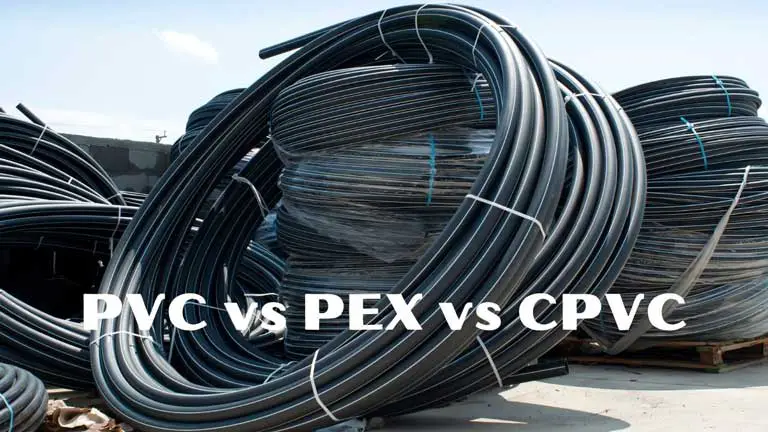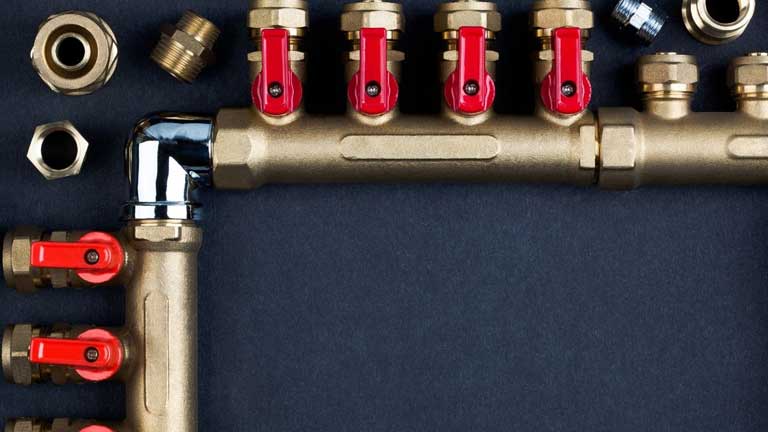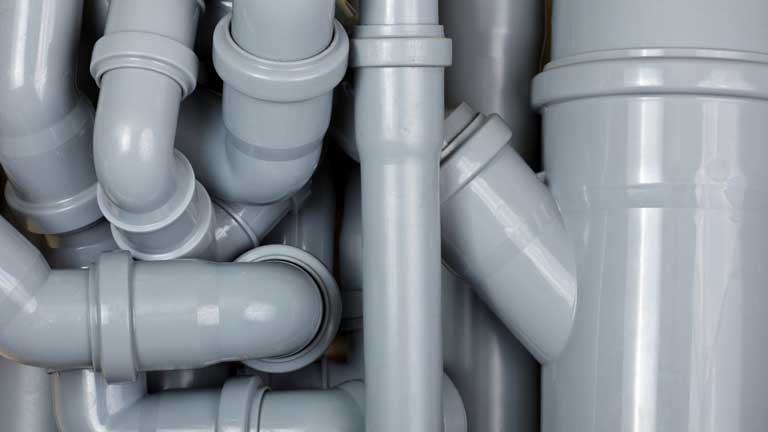Are you confused between PVC and CPVC? Or maybe you want to see how PVC and PEX differ, or CPVC and PEX. That’s a whole lot of acronyms jumbled in there. Don’t worry – we got you covered.
Wrong pipes can cause serious damage, and that’s why we remain extra cautious when appointing a plumber, selecting plumbing tools and supplies, and so on!
To give you a clear idea of PVC, PEX, and CPVC so that you can make an informed decision, we went an extra mile researching and accumulating the information for you. So, without any further ado- let’s get on topic.
Difference Between PVC vs PEX vs CPVC:
It isn’t easy to select the best pipe that stands out amazingly at every point. But how are we supposed to know what is best for our residential piping until and unless we are unaware of the products’ differences?
If we talk about PVC, PEX, and CPVC, then these pipes are made up of plastic, making them highly affordable and reliable for installation. While all the pipes sound the same, here are the differences between PVC, PEX, and CPVC-.

Material Quality:
The corrosion resistance feature of PVC makes it preferable among builders and plumbers. Also, these pipes are affordable, but it doesn’t mean they are made of low-quality material. Ultimately, it makes them safe to use for outdoor installation.
PEX piping for outdoor purposes has a low tendency to bear UV rays. PEX pipes are designed mainly for indoor usage. At the same time, while using PEX piping, we have to consider many safety factors.
Whereas, if we talk about CPVC, then it is corrosion-resistant as well, like PVC. The features and rigidness of the CPVC pipe make it best among other tubes. The CPVC pipes are safe for potable water and have higher reliability. Its fire protective feature makes it highly durable.
Read: PEX Cinch vs Crimp Comparison
Behavior:
The behavior of each pipe makes them unique from each other. If we talk about PVC, Polyvinyl Chloride, it is widespread among the plumbing codes since the 1960s. However, PVC and CPVC (Chlorinated Polyvinyl Chloride) are very similar in behavior as they both are made up of the same rigid material, “thermoplastic.”
PVC pipes are usually used for drainage pipes. Furthermore, these pipes are reported effective in protecting the environment due to their rigid material, and regardless of that, the PVC pipes are resistant to moisture and abrasion. Also, these pipes are entirely eco-friendly.
PEX, Cross-Linked Polyethylene, is known to be a flexible pipe. The formation of PEX is assured by medium or highly dense polyethylene, which itself known to be the pliable plastic. Due to the material, this plastic PEX pipe can flex up to 90°.
Mostly the plumbers find PEX pipes to be more reliable due to their flexibility. The PEX piping is mainly used for the distribution of water, whether it’s cold or hot. You will be amazed to know that this piping is primarily used in plumbing rather than construction.
Well, CPVC is known to be the best in terms of plumbing and construction. Just like PVC, CPVC pipes are chlorinated from a free radical chlorination reaction. The thermoplastic material makes it also useable for hot and cold water.
Meanwhile, the use of CPVC does not risk the safety of our loved ones. CPVC pipes are preferably considered for industrial and process piping applications, among other available lines in the market. Moreover, the CPVC pipes are more durable than PVC.

Life Span:
PVC pipes are reported to have a life span of about 50 to 70 years. Considering its life span, you can tell it is pretty reliable for industrial use. It is also best for outdoor installations as they are safe to use in commercial applications. On the other hand, CPVC and PVC have the same life span.
Talking about PEX, you will notice that it does not have such a great life span, but it is still reliable and sturdy when used under safety measurements. PEX pipe doesn’t last long compared to CPVC and PVC as their life span is approximately 40-50 years.
Read: PEX A vs PEX B Comparison
Temperature Bearability:
Considering PVC, it is best for water lines and DWV applications. Simultaneously, make sure to avoid PVC pipings for hot water lines as this pipe has quite a low tendency to bear the hot water and can only bear up to 140°F temperature. The PVC pipe can react dangerously when it interacts with hot water.
Well, if we compare the temperature bearability, the PEX and CPVC pipes tend to tolerate the temperature up to 200°F. All these pipes are widely used in residential plumbing as they are highly affordable and reliable.
UV Tolerance:
If PVC pipes directly interacted with heat, it can show “UV degradation.” Meanwhile, the CPVC does the same, but in many cases, these CPVC pipes are painted with UV-resistant paint, making them secure when installed outdoors. PEX pipes are not a great candidate to bear UV rays. That means these pipes can’t tolerate heat or UV rays.
The results will be far worse if the pipe interacted with UV rays. This is why it is often suggested to use PEX pipes only in indoor plumbing installation. However, if you are thinking of using PEX for outdoor installation, you must install them underground. Installing the PEX pipe on the ground may result in danger due to its interaction with the sunlight.

What To Avoid?
However, we cannot use PVC pipes for hot water applications. While fixing PVC pipes, every connection needs an elbow, and they also have a risk of leakage.
CPVC pipes are known to be rigid pipes, but still, they can break into a freezing temperature. Moreover, they cannot tolerate the direct exposure of sunlight, as it leads the pipe to degrade. Avoid the CPVC from toxic fumes as it serves severe risks in a house fire.
There are many points one needs to consider while using PEX. Moreover, PEX cannot bear UV rays, and it cannot survive extreme weather.
Read: Copper vs PEX: Which Piping Material to Choose?
CPVC vs PEX vs PVC Table:
| PVC | CPVC | PEX |
| PVC pipes are best for cold and warm water applications. | CPVC is best for both hot and cold water applications. | PEX pipes are best for water supply and gas lines. |
| PVC pipes cannot tolerate hot water. | CPVC pipes cannot afford freezing temperature. | PEX has zero tendencies of tolerating the UV rays. |
| The life span is about 50 – 70 years. | CPVC pipes can last up to 50 – 70 years. | The life span is about 40 – 50 years. |
| PVC pipes can bear temperatures up to 140° F. | CPVC can bear temperatures up to 200° F. | PEX pipes can bear temperatures up to 200° F. |
| PVC pipes can work fine for outdoor installation. | CPVC pipes are best when installed underground. | PEX pipes are best for indoor installation |
| PVC is less costly than PEX and CPVC pipes. | CPVC pipes are pricy than PEX pipes. | PEX is costly as compared to PVC or CPVC pipes. |
Which Pipe To Consider:
Different plumbers suggest different pipes, but in the end, it depends on you to choose the best one. So, to help you select the best tubes, here are some points that will clear all the confusion and help you pick the safest pipe.
Each pipe has different attributes that make them unique. If we talk about PVC, then we can use it outdoors easily, but the rigid structure of PVC needs elbows for fittings that are not affordable in PEX pipe.
On the other hand, CPVC pipes are highly similar to PVC. We can also use CPVC for outdoor installations to tolerate UV rays, but the price of CPVC is higher than PEX and PVC. PEX pipes are considered the best amongst all, yes! You heard that right. However, PEX works better than PVC and CPVC because PEX is purely designed for indoor installations.
Read: Top Quality PEX Crimping Tool For Tight Spaces
Conclusion:
Summing up, choosing between PVC, PEX, and CPVC is not an easy job for someone who is not familiar with all these three pipes. Therefore, when it comes to choosing the best, they get confused, as they are not aware of the differences between these pipes.
Moreover, to help you out, we discussed a few of the main differences between these tubing pipes. Using the best tubing system is what everybody wants these days. After all, it concerns the safety of our loved ones.
Hence, we suggest that using PEX pipe is the best choice for both indoor and outdoor usage. We hope this article was helpful enough to pick one among the three.
Leave a Reply